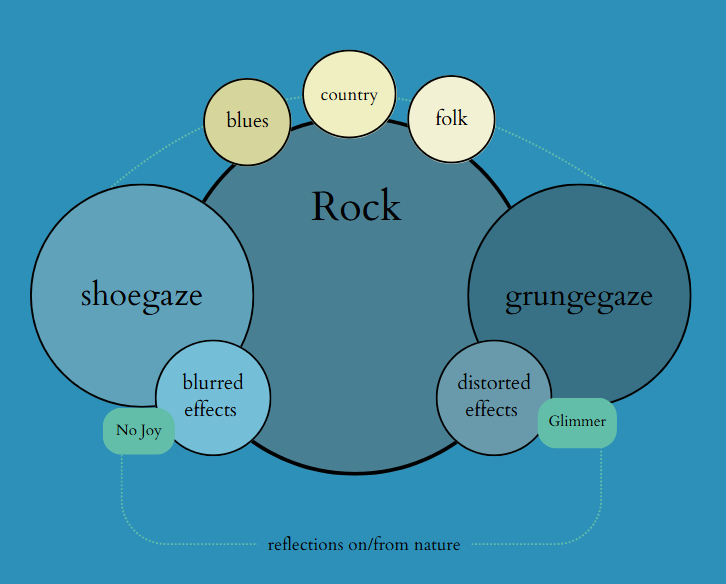“[I]t’s what happened to your fore parents and other people. And that’s what makes the blues.”
John Lee Hooker
Last year I went to Pond’s concert in Asheville, the day after in a town over we told a barista and he asked if they are ‘like shoegaze’; I said yeah thinking ‘shoegaze’ was the band Slowdive.
A year later I’ve delved into shoegaze and most notably grunge gaze, a la Wisp opening at Slowdive, interviewing New York’s Glimmer, reddit acclaimed shoegaze No Joy and listening to California’s Midrift, Arizona’s Glixen and Connecticut’s Ovlov.
These genre evolutions from Rock, with its roots respectively in Blues, Country and Folk, reflect conversations between industrialization and balance with nature and distortions organic and synthetic as well as personal and collective struggles.
Speaking with Glimmer’s Jeff Moore, he mentions transitioning from Brooklyn and urban life to a more natural rural setting, how often a walk in the woods can help his creative process and reveal how the piece hes working on should be.
Similarly, Canada based No Joy’s Jasamine White-Gluz discusses inspiration for her new album ‘Bugland’ which explores feelings of exploration into natures chaotic and diverse systems, feeling like entering another world or land. Rooted in experimentation, it makes sense a band so genre bending and oozing would take notes from nature and its patterns having millennium to curate an expansive ecological playground.
Returning to its roots in Country and Folk, elaborations from Rock like Shoegaze and Grungegaze work to further develop the image of music genres as archival in the way they document and trace cultural contexts such as the plight of the working class.
“I was just a boy and they put me to workin’ right alongside the men. . . Every man would be hollerin’. . . You might call them the blues but they were just made up things.”
Muddy Waters
Blue’s origins in a form of communication between oppressed African groups ties itself to our current music industry featuring “A direct path from the most ancient blues form up through rhythm & blues, rock & roll, soul, funk, disco, all the way to rap.” highlighting music as artistic, cultrual historical touchpoints
The echoes of hardship that reverberate through blues and its descendants are still present, even as these sounds evolve and shift into new forms. They pose the question post-commodification: who profits?
This idea of ‘culture vultures‘ in particular to the blues is presented in Sinners in its portrayal of Americana and the effect of whitewashing as seen with Elvis and other figureheads who profited from the craftsmanship of underrepresented and oppressed groups.
“It’s what happened to your fore parents and other people”. While I drove up to New Yorks Appalachia nestled in Hamden New York, fresh off a visit to my great aunt, I felt moved by the revealed relics of my ancestors moving through me.
When I find the tombstones of family names of mine and those I know alike in the cemetery down the street I feel larger and small, a bug, a giant, a blip, a monolith.
Jasamine White-Gluz of No Joy mentioned inspiration from fashion in our interview, this idea of futuristic ideas yet often reminiscent of natures codes and patterns, reflecting organic chemistry’s motto: nothing new under our sun.

